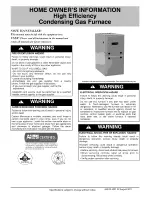
SERVICING
33
CHECKING DUCT STATIC
WARNING
Never allow the products of combustion,
including carbon monoxide, to enter the return
duct work or circulation air supply.
Refer to your furnace rating plate for the maximum ESP
(external duct static) rating.
Total external static refers to everything external to the
furnace cabinet. Cooling coils, filters, ducts, grilles,
registers must all be considered when reading your total
external static pressure. The supply duct pressure must be
read between the furnace and the cooling coil. This reading
is usually taken by removing the “A” shaped block off
plate from the end on the coil; drilling a test hole in it and
reinstalling the block off plate. Take a duct static reading
at the test hole. Tape up the test hole after your test is
complete. The negative pressure must be read between
the filter and the furnace blower.
Too much external static pressure will result in insufficient
air that can cause excessive temperature rise. This can
cause limit switch tripping and heat exchanger failure.
To determine total external duct static pressure, proceed as
follows:
1.
With clean filters in the furnace, use a draft gauge
(inclined manometer) to measure the static pressure
of the return duct at the inlet of the furnace. (Negative
Pressure)
2. Measure the static pressure of the supply duct. (Positive
Pressure)
3.
The difference between the two numbers is .4” w.c.
Example:
-1
0
1
2
3
Difference is 4
static reading from return duct = -.1” w.c.
static reading from supply duct = .3” w.c.
total external static pressure on this system = .4” w.c.
NOTE: Both readings may be taken simultaneously
and read directly on the manometer if so
desired. If an air conditioner coil or Electronic
Air Cleaner is used in conjunction with the
furnace, the readings must also include theses
components, as shown in the following drawing.
4. Consult proper tables for the quantity of air.
If the total external static pressure exceeds the maximum
listed on the furnace rating plate, check for closed
dampers, registers, undersized and/or oversized poorly laid
out duct work.
The temperature rise of the furnace must be within the
temperature rise range listed on the furnace rating plate.
.
Checking Static Pressure
CHECKING TEMPERATURE RISE
The more air (CFM) being delivered through a given
furnace, the less the rise will be; so the less air (CFM)
being delivered, the greater the rise. The temperature
rise should be adjusted in accordance to a given furnace
specifications and its external static pressure. An incorrect
temperature rise may result in condensing in or overheating
of the heat exchanger. An airflow and temperature rise
table is provided in the blower performance specification
section. Determine and adjust temperature rise as follows:
1.
Operate furnace with burners firing for approximately ten
minutes. Check BTU input to furnace - do not exceed
input rating stamped on rating plate. Ensure all registers
are open and all duct dampers are in their final (fully or
partially open) position.
2. Place thermometers in the return and supply ducts as
close to the furnace as possible. Thermometers must
not be influenced by radiant heat by being able to “see”
the heat exchanger.













































